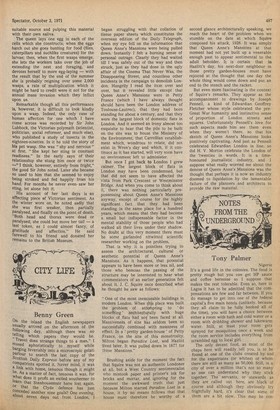Peter Quince
Wasps seem to be abnormally plentiful this year. I say "seem to be" because I half-suspect we make the same observation eery year. I suppose it must some times be true. Usually, though, it is simply that the life-cycle of the wasp, with its slow, secret build-up of numbers and its sudden show of strength at the end of the season, retains its power to take us somewhat by surprise.
Except in the case of those people who have an irrational dread of spiders, wasps must be the most unpopular of all insects in this country. There is something unsettling even about the low drone they make in the air, and their black and yellow mark ings appear hostile and fierce. Anyone who has ever been stung by one is unlikely to forget the experience; certainly it is many years since I suffered a wasp sting, but remember with great clarity the searing pain it caused. Possibly the chief thing in wasps' favour (from a human point of view) is that they are, in fact, unlikely to make use of their armament unless they feel themselves to be under attack. This bY no means leads to an entirely satisfactory state of peaceful co-existence, since if one of the brutes is sat on or bitten or otherwise accidentally threatened, it will not pause to consider the motives of its assalient before counter-attacking. Still, it is something.
We do our best to destroy any wasps nests near the house. It is surprisingly hard to track the creatures to their lair; this can be done by patient observation, but it -takes time. The only short-cut I have ever heard recommended involves tying a long white thread around a wasp and then watching it travel, much slowed and much more visible as a result of this treatment, back to the nest. I dare say it works verY, well for anyone who fancies the job 01 harnessing a wasp. I find it unappealing. The nests usually turn out to be in holeS in the ground, although I have found then inside buildings and in rotten tree-sturnOs. They are, as a matter of fact, rather mar' vellous constructions (not that I allow this to soften my feelings towards them). The impressive fact is that each of these tri' tricate, beautifully built colonies is the work of one short summer. Unlike bees, wasps cannot make honey and so are unable to prolong the life of their cony munities beyond one season. In the spring, therefore, the queens have to s about re-creating social life when the emerge from their solitary hibernation' They build small nests for themselveSi about the size of a hen's egg, out of wile is in fact pure paper: they manufactute5 their own paper by scraping tiny shaving, of wood from fences or some othe' suitable source and pulping this material with their own saliva. The queen lays one egg in each of the cells which she constructs; when the eggs hatch out she goes hunting for food (flies, caterpillars and suchlike creatures) for the larvae; then, when the first wasps emerge, she lets the workers take over the job of extending the nest and foraging, and devotes herself to more egg-laying — with the result that by the end of the summer she is probably reigning over some 2,000 wasps, a rate of multiplication which it might be hard to credit were it not for the annual mass invasion which they inflict upon us. Remarkable though all this performance is, however, it is difficult to look kindly upon a wasp. Indeed, the only case of human affection for one which I have come across was recorded by Sir John Lubbock, the Victorian polymath (scientist, politician, social reformer, and much else), who published a study of insects in the eighteen-nineties. In it he told the story of his pet wasp. She was "shy and nervous" at first. " She kept her sting in constant readiness." In the early says of their relationship she stung him once or twice —" I think, however, entirely from fright," the good Sir John noted. Later she became so used to him that she seemed to enjoy being stroked and fed happily from his hand. For months he never evensaw her sting, let alone felt it. His account of her last days is an affecting piece of Victorian sentiment. As the winter wore on, he noted sadly that she was first weaker, then partially Paralysed, and finally on the point of death. 'Both head and thorax were dead or Paralysed; she could but move her tail — a last token, as I could almost fancy, of gratitude and affection." He said farewell to his friend and donated her remains to the British Museum.

































 Previous page
Previous page